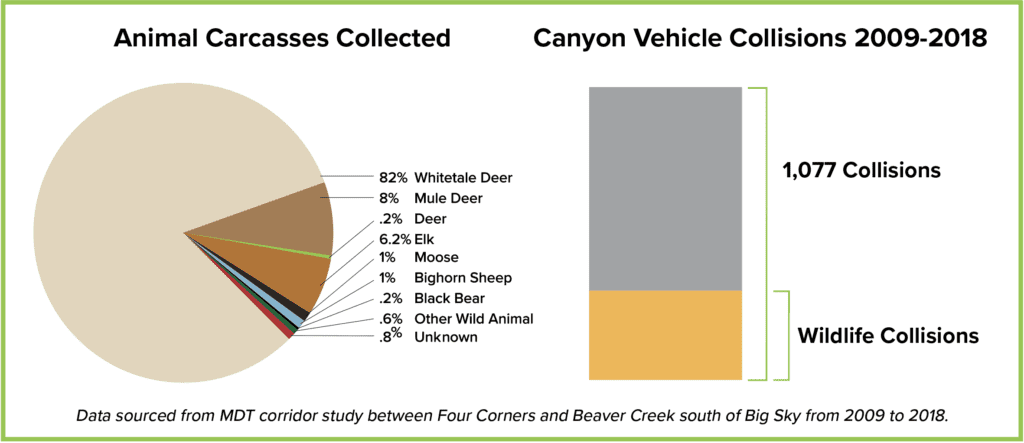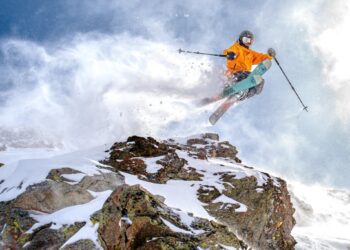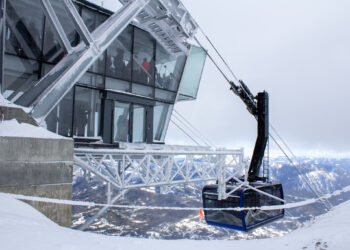Solution seekers look to wildlife crossings as future fix
By Julia Barton EBS CONTRIBUTOR
GALLATIN GATEWAY – On most days, drivers traveling along the section of U.S. Highway 191 colloquially known as “the Canyon,” are treated to views of bighorn sheep lapping up salt on the roadside, elk grazing and deer gallivanting through the woods. Unfortunately, as the most direct route north from West Yellowstone to Bozeman and the sole public road providing access into Big Sky, this is an especially dangerous route for human travelers and wildlife alike.
Montana ranks second among all states for most wildlife-vehicle collisions, and this perilous passage is a significant contributor. As the rapidly growing area continues to explode with human development, experts and residents suggest improvements must be made to the roadway.
The Montana Department of Transportation reports that Gallatin County’s population has grown by 25 percent since 2010 and is projected to continue to grow at a rate of 2.5 percent annually through 2040. This equates to anywhere between 7,000 to 17,000 vehicles driving the Canyon between Big Sky and Bozeman each day. In other words, this single-lane road is really feeling the weight of an increasing population.

In a corridor study completed in October 2020, MDT surveyed a 37-mile stretch of U.S. 191 from Four Corners to Beaver Creek Road just south of Big Sky and reported that nearly a quarter of the 1,077 vehicle crashes from 2009 to 2018 were related to wildlife collisions. More than 90 percent of the wildlife carcasses collected from those collisions were deer, a pattern seen across the state.
“[Deer collisions] are a primary concern on our other major north-south routes in southwest Montana being the Madison Valley and U.S. Highway 287, Paradise Valley on U.S. Highway 89 and Interstate 15,” said Deb Wambach, the district biologist for MDT. “We have lots of wonderful wildlife, and we have lots of people driving our highways.”
The remaining 10 percent of wildlife collisions involve other large mammals in the area such as elk, moose and bighorn sheep, which occupy select stretches along U.S. 191. Julie Cunningham, the Bozeman area wildlife biologist for Montana Fish, Wildlife and Parks, explained that wildlife is often attracted to low elevation areas that run alongside the river and, subsequently, the highway. U.S. 191, which parallels the Gallatin River, is a prime example.
Longtime Gallatin Valley local Holly Pippel has been following the movement of elk herds near Gallatin Gateway on U.S. 191 and its offshoots for years from behind the lens of her camera. She began interacting with elk almost daily in the late 1990s while working on the Flying D Ranch on the north end of the Canyon and has been photographing them ever since, intrigued by their travel routes and social behaviors. Pippel is drawn to watching how elk travel in and out of human development and catalogues this unique intersection in stunning photographs.
In her time watching elk behavior change as the Gallatin Valley has boomed in population, Pippel says that although the problem of elk being killed near roads has increased, she believes elk are getting smarter and adapting to the changing environment. She urges Montanans to adapt to the growth in a similar fashion.
“A lot of people are blaming it on out-of-staters, and to be honest, it’s a lot of us who live here in the valley and are commuting for work that need to be a little more conscious and patient for the wildlife as we get busier,” Pippel said.

A solution often proposed for mitigating wildlife deaths on highways are crossing structures–either underpasses or overpasses–that physically separate wildlife from the roadway. Many such structures have been successfully implemented along other Montana highways. Along U.S. Highway 93 on the Flathead Reservation, for example, MDT constructed 39 crossing structures in 2005, which have proven effective at decreasing wildlife-vehicle collisions along the roadway. Deer, the most common animals to fall victim to collisions, were found to use the structures the most frequently.
One of the difficulties in introducing such corssings is deciding on a single spot for a wildlife crossing structure, Cunningham and Pippel both explained, as animals generally don’t cross the road at a specific mile marker. To be successful, a crossing would have to link existing wildlife corridors together that cross the road and often require miles of fencing to guide animals to the crossing. Not only does this introduce additional costs, but it would impact landowners in the corridor and requires in-depth research for fences to be adequately located.
Finances are a clear barrier to integrating a project such as a wildlife overpass; the 2005 project totaled more than $21 million. The Big Sky Area District in 2021 allocated $50,000 of resort tax funding to the Bozeman-group Center for Large Landscape Conservation that is being used to fund an assessment of U.S. 191 to determine where an adequate location for a potential wildlife crossing may be.
In November 2021, Congress passed the Infrastructure Investment and Jobs Act, which designated $350 million of federal funds to the Wildlife Crossings Pilot Program. The program aims to provide funding to projects that will reduce the number of wildlife-vehicle collisions and improve habitat security for wildlife populations near roadways. Wambach noted that MDT is working to best situate itself to use some of these federal funds for Montana highway projects, such as a potential solution along U.S. 191.
In the meantime, perhaps the fastest and cheapest mitigation strategy is to help drivers in the Canyon be more aware of the risks and how they can take precautions.
“A lot of it is from the human behavioral end, it is not about fixing the animals so much as it is fixing the people,” Cunningham said. This can take the form of improved and dynamic signage to vegetation management, making it easier for drivers to spot animals near the roadside.
Wildlife activity in the Canyon increases in the fall, and dusk or dawn hours are the most dangerous time to drive in areas with extensive wildlife. Wambach believes it’s worth taking things slower and being extra alert for animals on the roadside or avoiding driving during these times altogether when possible.
Wambach says it’s not just about the collisions, it’s also about the animals’ ability to move through their corridors. Looking toward the future as development in Gallatin County and along U.S. 191 increases, the roadway will likely become difficult for animals to cross at all.
“You actually start to see a drop off in [wildlife collisions] because the highway and the traffic volumes begin to act as a barrier to movement,” Wambach said. “…It’s about habitat security, as well as ensuring that the highway is permeable to wildlife movements.”















